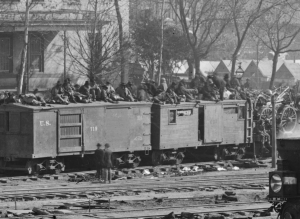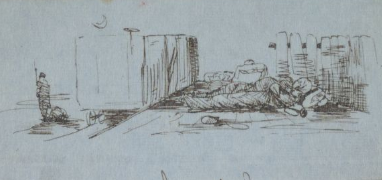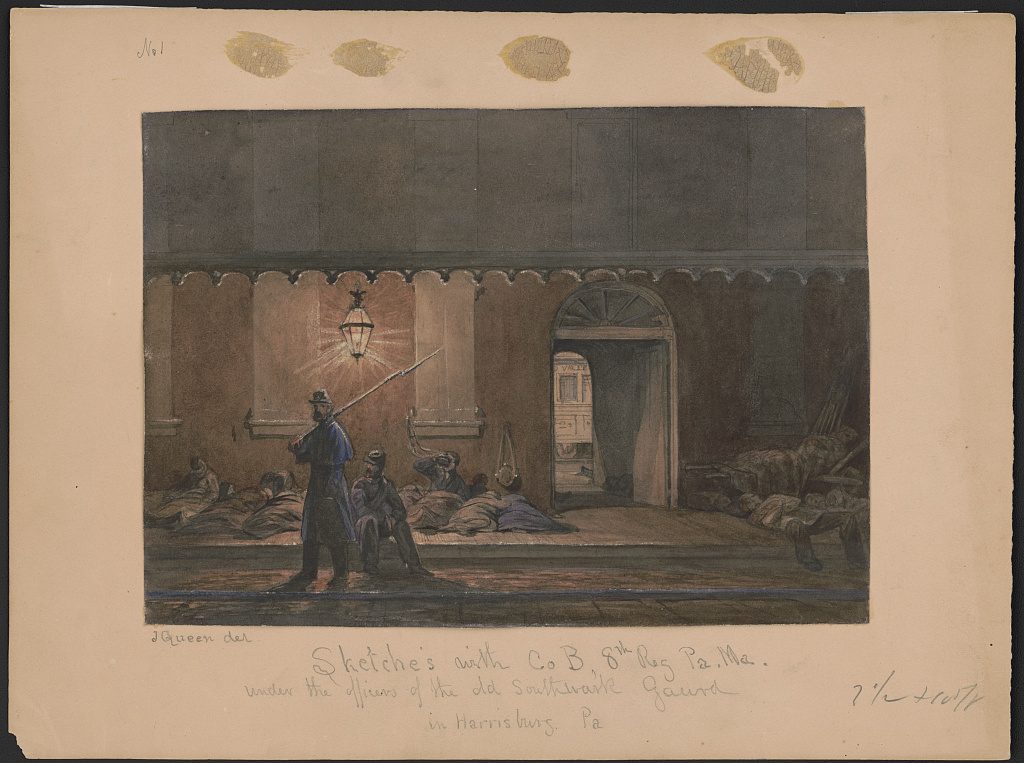Railroads – Riding the Rails: Union Soldiers Experience Train Transport in the Civil War

At the time I am now writing, about fifteen thousand United States soldiers have recently been transported… to various points adjacent to the Mexican border, for the purpose of protecting American interests. And it seems that in some cases the soldiers were carried in ordinary passenger coaches. Thereupon bitter complaints were made on behalf of such soldiers because Pullman sleepers were not used! And these complaints were effective, too, for… the use of passenger coaches for such purposes was summarily stopped and Pullmans were hurriedly concentrated at the places needed, and the soldiers went to war in them.
The reports that “Uncle Sam sent his soldier boys to the front in Pullmans” urged him to reflect on his own experiences riding the rails during the Civil War. He wasn’t incensed, “for the government could well afford to do it, and it was right,” but changing attitudes towards military transportation in just over just half a century necessitated a comment from this old veteran:
Such a thing as even ordinary passenger coaches for the use of the enlisted men was never heard of… The cars that we rode in were the box or freight cars in use in those days. Among them were cattle cars, flat or platform cars, and in general every other kind of freight car that could be procured. We would fill the box cars, and in addition clamber upon the roofs thereof and avail ourselves of every foot of space. And usually there was a bunch on the cow-catchers. The engines used wood for fuel; the screens of the smoke-stacks must have been very coarse, or maybe they had none at all, and the big cinders would patter down on us like hail.
He affirmed that regardless of the mode, he and his comrades were “awful glad” to ride the rails.[1] For many Union volunteers train travel was at first an exciting experience, but smoky and cramped cars, dusty in hot weather and damp in the rain, soon wore away at the novelty.

Artilleryman Jenkin Lloyd Jones noted in his diary in November 1862 that after three days laying on the Corinth platforms his regiment were finally able to scramble “on top the freight cars to procure transportation.” It was raining, and as the train lumbered along the cinders from the smokestack were “torturous.”[2] Another soldier, riding the uncovered platform cars on a scorching June day in Virginia, wrote home that the cloud of dust whipped up by the locomotive made his journey an unpleasant one.[3]
But some were luckier, like Louis Richards of the Pennsylvania militia, who was afforded the luxury of taking a passenger train and disembarking to a “concourse of citizens assembled at the depot with a band of music” after General Robert E. Lee’s failed invasion of Maryland in 1862. Poignantly, he juxtaposed his buoyant journey with a “dreadful accident” that struck a fellow militia regiment on their return home. Their train collided with another, leaving four dead and some thirty injured.[4] It was a stark reminder of the ever-present spectre of calamity that hung over the railroads.
Travelling by train was rarely as pleasant as Richards’ brief sojourn, but often lifted the troops’ spirits because it meant a break from monotonous marches or an escape from even less disagreeable forms of transportation. Zenas T. Haines of the 44th Massachusetts Volunteer Militia wrote home of his railroad journey to Newbern, North Carolina on an open platform car that was exposed to a “violent rain” that drenched the passengers. But the “mild and invigorating breezes of the old North State” contrasted “so deliciously with the foetid atmosphere and filth” of the bowels of steamer USS Merrimac which he had recently occupied.

Riding the rails in the Civil War ranged from the monotonous to the exhilarating, and from the comfortable to the downright miserable. But it was a chance for the soldier to rest his weary limbs whilst thundering past new towns, landscapes, and peoples. As a soldier, Stillwell never experienced the luxury afforded to troops of the early twentieth century, nor that enjoyed by his more fortunate contemporaries. In spite of the trains’ shortcomings, it is evident that they always provided a marked contrast from the conventional drudgery of the march, and why Stillwell was always glad to ride them.
Sources:
[1] Leander Stillwell, The Story of a Common Soldier of Army Life in the Civil War, 1861-1865 (Kansas City: Franklin Hudson Publishing Company, 1920), 104-105
[2] Jenkin Lloyd Jones, ‘Diary Entry, Corinth, November 12, 1862,’ in Jenkin Lloyd Jones, An Artilleryman’s Diary (Madison: Wisconsin History Commission, 1914), 12
[3] Warren Hapgood Freeman, ‘Warren Hapgood Freeman to J. D. Freeman, June 22, 1862,’ in Letters from Two Brothers Serving in the War for the Union to Their Family at Home in West Cambridge, Mass. (Cambridge: H.O. Houghton, 1871), 37
[4] Louis Richards, Eleven Days in the Militia during the War of the Rebellion; being a Journal of the “Emergency Campaign of 1862” (Philadelphia: Collins, 1883), 51-52
[5] Zenas T. Haines, ‘Letter from Zenas T. Haines, October 26, 1862,’ Letters from the Forty-Fourth Regiment M.V.M.: A Record of the Experience of a Nine Months’ Regiment in the Department of North Carolina in 1862-3 (Boston: Herald Job Office, 1863), 35

Cattle cars… the reference invoked reminiscence of a passage, found in Genoways’ “A Perfect Picture Of Hell,” describing the transport of Union prisoners, captured at Shiloh, forced to ride from Corinth to Memphis in “hastily prepared cattle cars, emptied of their four-legged cargo, but not cleaned.” When it is contemplated what is meant by “not cleaned,” coupled with the fact the prisoners “attempted for hours to stand above the muck, which over-topped their brogans,” until one by one, due to the extended length of the journey, forced to sit in it…
Now, you understand the horror of riding in cattle cars.
That’s an account as fascinating as it is harrowing Mike, and not something I’d considered in this brief post, so thank you for sharing it. It would be interesting to have a comparison of the experiences of soldiers when forced onto the trains of their adversaries. Equally fascinating would be further investigation of soldiers’ experiences aboard cars carrying the wounded. Indeed, there are a multitude of variables to bear in mind when considering the forced intimacy of troop transportation on trains.